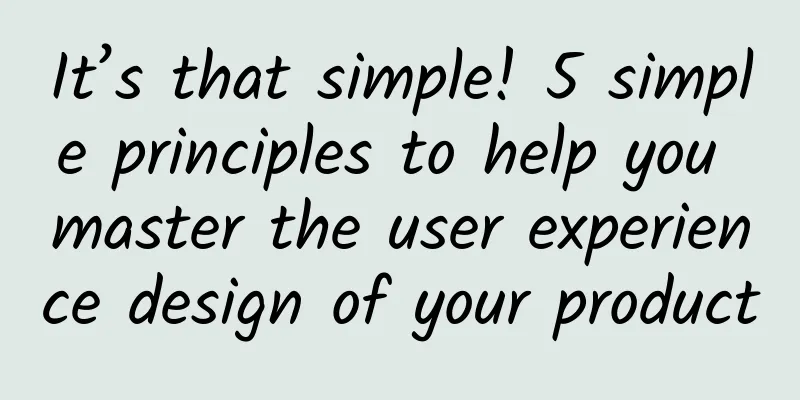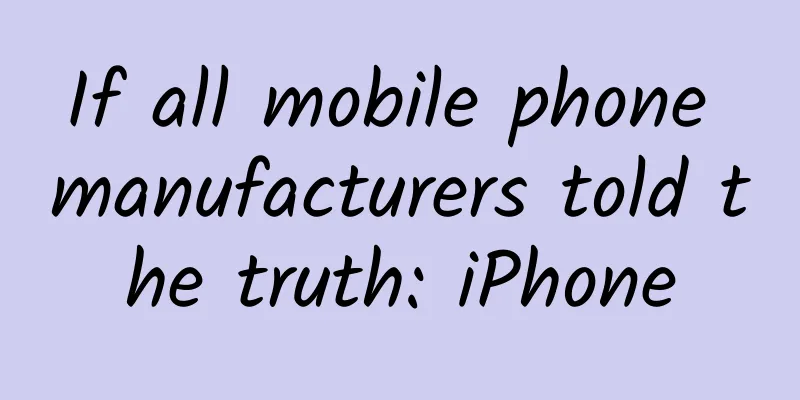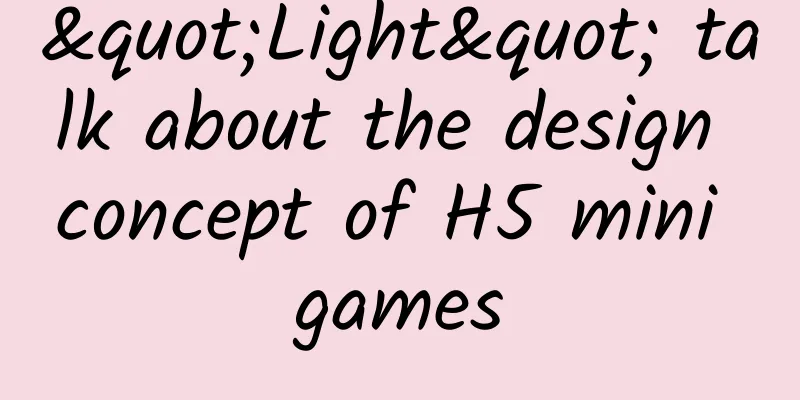It’s that simple! 5 simple principles to help you master the user experience design of your product

|
Many things in life are changing rapidly, and there are not many things that remain unchanged, such as death, which is inevitable, and the 7 o'clock news broadcast. In such a complex and changing era, how can we do a good job in user experience design? As a user experience designer, I have practiced countless ideas over the years, trying to find the best answer to user experience design. It seems complicated, but it is also simple to say. In the process of exploration over the years, my biggest feeling is that the work of a user experience designer is essentially to go deep into the user's brain to find the answer. We need to understand the real views of a large number of users on design, analyze and dissect this information, and sort out the potential problems and confusion they face. Continuous user experience design is a never-ending process during, before, and after the design process. It is a great challenge for designers to consider user behavior at all times. In order to keep product design on the right track, I have summarized 5 simple user experience design principles and used them as an important reference for my design process. Understanding the design decisions of user experience design and explaining them to team members is not an easy task, and it takes a long time to finally implement them in the product. 1. Easy to digest
Good design should be easy for users to digest - the brain should not spend a lot of brain cells to analyze what the eyes see. If the design is easy to understand, visitors and users will quickly "get it" without spending half an hour reading the description below that is more than a thousand words divided into 6 paragraphs. This is not just about designing clear and readable copy. Users need to make the right decisions with the right visual guidance, and a menu with 12 pure texts is outrageous (Amazon's Fire Phone settings menu is like this and has been criticized to bits). Organizing information through font size/weight, color, and icons can highlight important information/options and help users find what they want faster. Another example is the common user guide for new users. Usually, they are small tips that are covered on the interface layer. They are divided into multiple different steps. Click one to enter the next one. But on the other hand, think about it from the user's perspective. Do you really like this thing? A bunch of unexpected instructions pop up in unexpected places in the interface. Can you or your users really digest so much information? Think about it, the information and things you have tried so hard to get users to obtain will eventually flow away like water in a funnel. This is really a huge waste of your efforts and product information. The efficiency and quantity of information obtained by everyone's brain are quite limited. Use it reasonably and don't be too rough. 2. Clarity
Good design is honest, which is also what the design master Dieter Rams said. In addition to conveying your values through content and design, you also need to let users understand the actual value. Ambiguous expressions and unclear products will not win fans. Define the core value of the product and clearly express everything around it. If users don’t know the details of your payment system, they won’t click “Buy Now” without hesitation. Although many teams choose to use “free trial” to obtain user information and then transition to automatic payment, can this approach really gain user trust and recognition? Although it sounds cheesy, the golden rule for solving product clarity problems is to explain clearly and make everything transparent and clear. You want everything you use to be clear and intuitive, so don't deceive your users. 3. Trust
Good design should be trustworthy and easy to believe. When asking users to perform an action, make every effort to help them understand why this action is necessary. Each step needs to rely on honest and clear statements to build trust, gradually accumulate, and enhance the user's trust bit by bit. Look at Uber, Lyft and Airbnb. These apps have carved out a path in these relatively chaotic industries, not only because they have given a lot of subsidies, but also because they have invested a lot of thought in the construction and security of their service systems. These apps keep users' payment and personal information very well (especially Airbnb). You may feel a little uncomfortable when you first start communicating with strangers, but as you use them, you will trust them more and more, and the transaction risk is much lower than that of other apps. 4. Familiarity
Breakthrough design is cool, but design that’s made with heart is even better. Cool effects and new frameworks on Dribbble look great, but if no one clicks the buy button, you’re in trouble. There is a reason why the design specifications of each platform exist. Although it seems that the design specifications are intended to make the product look more consistent across platforms, please pay attention to those consistent and sticky design details, familiar patterns, the same icons, and unified styles, which essentially create a native feeling and make users feel familiar. Of course, these design solutions can only be tested on actual devices to see if they are feasible. If you want to make users feel familiar and at home on each platform, there is still a long way to go. This is what tools like InVision try to help users do. 5. Make people happy
Generally speaking, good ideas alone are not enough, good execution is needed to win the competition. The more the design team executes, the less the user needs to do. The better the complex problem is simplified, the greater the pleasure the user gets from the solution. When your product is good enough and brings enough pleasure to users, users no longer regard it as a "product" or realize it is a "tool", but regard it as a practical and indispensable part of life, which also means that the product is successful. On the user's side Building thoughtful products with clear intentions is proof that you really care about product design. Such products allow users to make choices more comfortably and create a better user experience. It is easy to judge whether a product is designed with care. It is to judge whether it is designed honestly and carefully for the user. Whether a pair of shoes is good or not, you can tell whether it is good or not by wearing it for ten kilometers. When you drag your tired body home, you can carefully recall every step you took while wearing it. This is also what we should do when facing our own products. |
<<: 4 secrets of programmers to maintain their value
>>: Square’s App Visibility Principles
Recommend
How to fill in the college entrance examination application form to get a higher admission rate? Tips to improve your admission rate
Recently, candidates for the 2020 college entranc...
Interesting explanation with pictures and text: What exactly is WeChat Enterprise Account?
Enterprise Account is a mobile application portal...
What's the matter with taking watermelon rind to the cafeteria to get food? Why do you take watermelon rinds to the canteen to get food?
Take watermelon rind to the canteen to get food U...
How to reduce the cost of attracting new customers through event invitations?
An invitation is a project: from an idea in the b...
Brand Marketing: How to make your Internet brand “seen”?
Internet brands frequently do things offline, inv...
A 35-year-old programmer can’t go home
Xi'erqi is the place with the highest proport...
iOS 16 was revealed to have an abnormal Apple ID login bug
It has been more than a month since the release o...
The underlying logic of new media operations
Due to the popularity of short videos and live br...
96% of mobile malware targets Android, report says
[[128326]] According to foreign media WarketWatch...
App commercialization principles and advertising space optimization!
When we come into contact with APP developers, we...
Just two days after the official release of WeChat 8.0.8, Apple iOS version 8.0.9 is here. What’s updated?
Recently, the news of the official release of WeC...
Microsoft Cortana released iOS and Android versions only available in China and the United States
After several months of beta testing, Microsoft&#...
The latest news on oil price cuts in 2022: When will they fall? Attached with the latest market information!
In recent years, due to the impact of the new crow...
Shaoxing Shengzhou pilots 4.5-day flexible work system (full text)
Shaoxing Shengzhou pilots 4.5-day flexible work s...
One article to solve the search advertising problems on Toutiao and Baidu
There are already many articles and tutorials on t...









